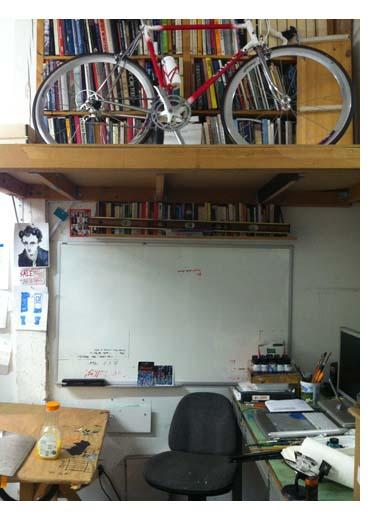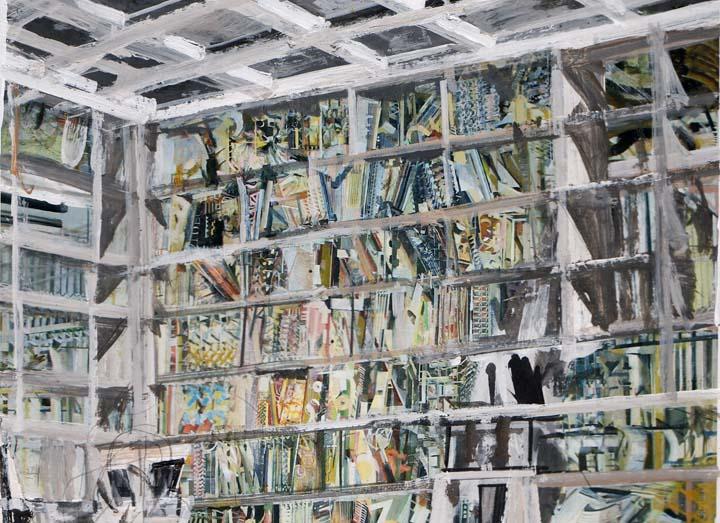Riccardo Vecchio's Bookcases
As the heatwave continues here in New York, there’s never been a better time to resort to a cool library full of books on art and design. So this week DART resumes its Bookcases department, in which artists and designers are invited to pimp their bookcases. We are pleased to launch this series with Riccardo Vecchio, Chair of School of Visual Art’s MFA Illustration as Visual Essay program and a longtime DART contributor.
Peggy Roalf: Do you remember the first art book you ever purchased? Why did it catch your attention?
Riccardo Vecchio: I don't recall buying my first art book. My first memories of consciously engaging with design/art books were weekly newspaper supplements on art that my dad brought home. My first real memory of buying art books, which was a massive investment at the time, was the Brockhaus Kunstgeschichte (art history) Encyclopedia when I moved to Germany in my 20s to study design.
PR: How many libraries do you have? How do they differ? Where are they located?
RV: My main library, if you can call it such, is in my studio in Queens. It is not well organized, narrow, and tall. Because of a lack of space, intruders like tools, woodblocks, bicycle parts, molds, lenses, and other gadgets disrupt its original function. I have a number of fiction and nonfiction books at home, and now I am organizing a new library at the School of Visual Arts in the MFA Illustration as Visual Essay department, which I will share for inspiration with all our students and faculty.
PR: What went into your choice of bookcases — any research? Any seen/envied among friends/colleagues? Any particular manufacturer.
RV: In my former loft in Brooklyn, all my neighbors, roommates, and friends were very handy and extremely talented furniture makers. They were my inspiration and encouragement to custom-build from the very beginning. The occasional IKEA shelf, though, never failed to make an appearance.

PR: Is there anything you might want to include about favorite libraries for doing research over the years?
RV: In high school in Milan, the class syllabus required visiting libraries to research the papers we were assigned. The Biblioteca Nazionale Braidense (below) and Biblioteca Sormani (above) were places I frequented often. When in Milan, I highly recommend visiting all three libraries, which have been open to the public since the 1600s, and I especially recommend the Sala Del Grechetto at the Palazzo Sormani (above). The Sala Del Grechetto is an unappealing conference room adorned by a gorgeous series of 23 room-sized paintings from the 1700s depicting the myth of Orpheus in a breathtaking botanic zoological diorama with 280-plus animals and hundreds of plants.
In New York, my favorite public library was always the Picture Archive, which was opposite the Schwartzman Building on 40th Street and Fifth Avenue. Before the internet, that was the place to discover and research pictures for upcoming projects. The Strand and all the small bookstores, especially in the East Village, were equally as relevant. Currently, whenever I visit the Brooklyn Public Library at Grand Army Plaza to work on my "31 Degrees" mural in the Dweck Gallery, I love spending time in the library's grand spaces and strolling through the incredibly well-curated display shelves exhibiting the best the publishing world has to offer.

PR: What went into your research and design process when you first contemplated building your own?
RV: All materials were construction materials. The design was always straightforward—Home Depot has everything one could need. Long wood planks resting on narrow wood rails screwed into the brick wall. The front of the planks were supported by 3 chunky 4x4s, for which I routed out a slot in the 4x4s to insert the shelves. Galvanized stud brackets held everything together. The ready-made shelves usually worked best for smaller spaces. The bookcases described above were roughly ten by eight feet.
PR: How you organize your photo, design, and art books?
RV: I don't. They are mostly organized and placed according to their size and weight. Occasionally, as I skim through books, and I discover some surprising combinations of covers or sketches sitting on a shelf, I turn them towards me so I can see them the next days and hopefully they will trigger new thoughts and ideas.
PR: What do you do when you run out of shelf space?
RV: I wish I had a system in place, but I don't. When I run out of space, and it has happened a lot, I unfortunately start filling the empty spaces between the top of the books and the shelves. I slide in the books horizontally, squeezing in anything I can to use that gap.
PR: Have you ever had to move your Library? What are the best and worst things about moving this kind of collection?
RV: Yes, I had. You'd think that the idea of physically moving all those books, one by one or in office boxes, always overloaded and prone to disintegrate and tear as you carry them, would be an incentive to get rid of everything you think might be outdated.
Somehow, though, at a second look at the outdated pile, it all ends up back in the keeper's stack. Although lately, I have become more ruthless and less sentimental about books, and I tend to put them out in the studio hallway to share them with fellow artists or bring them to school.
PR: Do you consider being a bibliophile a form of madness?
RV: Not necessarily. It is a way to create a record and a path through one's intellectual, fictional, and creative journey. It can be a personal archive where all your research material is at your fingertips. I frequently used my library in my paintings and sketches around 2006. It can also be simply a status symbol and an architectural extension.
Towers of books improve the acoustics of rooms and bring warmth and comfort to any interior. It can become madness, as with any other unrestricted obsession, when the love for books turns into hoarding. Newspapers, magazines, and ads become extensions of the library. Rows of books slowly grow into unnamed towers and blobs of paper and rags. Books will be buried so deep they will never be seen again. I have seen that in some apartments, when the yellowing paper stack starts building a narrow path, the smell of mildew on damp paper lies thick in the air,...then it is time to move to a bigger apartment.
All photos courtesy Riccardo Vecchio www.riccardovecchio.com. DARTbooksFeatures





